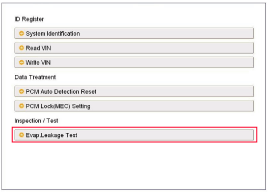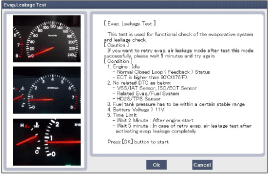[System Inspection]
| 1. |
Disconnect the vapor hose from the intake
manifold and connect a vacuum pump to the nipple on the intake
manifold.
· At Cold Engine [Engine Coolant Temperature
< 60°C(140°F)]
Engine
Operating
Condition
|
Applied
Vacuum
|
Result
|
Idle
|
Min. 20 inHg
(Min. 0.7
kgf/cm², Min. 67.7 kPa)
|
Vacuum is held
|
3,000rpm
|
|
| 2. |
Check the following points with applied vacuum
at the purge control solenoid valve (PCSV).
· At Warmed Engine [Engine Coolant Temperature
> 80°C(176°F)]
Engine
Operating
Condition
|
Applied
Vacuum
|
Result
|
Idle
|
Min. 20 inHg
(Min. 0.7
kgf/cm², Min. 67.7 kPa)
|
Vacuum is held
|
Within 3 minutes after engine start at 3,000
rpm
|
Try
to apply vacuum
|
Vacuum is released
|
In 3
minutes after engine start at 3,000 rpm
|
Min. 20 inHg
(Min. 0.7
kgf/cm², Min. 67.7 kPa)
|
Vacuum will be held momentarily, after which, it
will be released
|
|
[PCSV Inspection]
| 1. |
Turn ignition switch OFF and disconnect the
negative (-) battery cable. |
| 2. |
Disconnect the PCSV connector
(A). |
| 3. |
Disconnect the vapor hose (B) which is
connected to the intake manifold from the PCSV.

|
| 4. |
After connecting a vacuum pump to the nipple,
apply vacuum. |
| 5. |
With the PCSV control line grounded, check the
valve operation with battery voltage applied to the PCSV(Open) and
removed(Closed).
Battery
Voltage
|
Valve
|
Vacuum
|
Connected
|
Open
|
Released
|
Disconnected
|
Close
|
Maintained
|
|
| 6. |
Measure the coil resistance of the
PCSV.
Specifications:
22.0 ~ 26.0Ω
[20°C(68°F)]
|
|
[EVAP. Leakage Test]
| 1. |
Select "Evap. Leakage Test".

|
| 2. |
Proceed with the test according to the screen
introductions.

| |